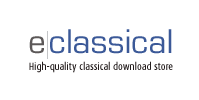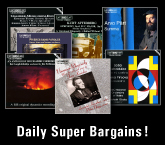You've downloaded music in 24 Bit format. Now what?.
Many audience recordings from live concerts are now available in 24 bit format, and many bands are selling "high resolution" music in 24 bit format (both soundboard recordings of live concerts, as well as studio albums). With more and more music becoming available in the 24 bit format, many people have lots of questions. This website will answer many of the basics, and will focus on 2-channel (stereo) recordings.
Yes, on most burning programs you can make an audio CD out of a 24 bit file. But audio CDs are limited to 16 bit so you will only get 16 Bit, 44.1 kHz (that's 44,100 samples per second, with each sample being 16 bits long). While it is very likely that your burning program can burn CDs from 44.1kHz 24bit files, you may want to confirm that it is also capable of sample rate conversion (that is if the source sample rate is higher than 44.1kHz). In any case there are simple solutions for that, too.
There are many ways to listen to 24 Bit files. You can burn them to DVD, either as a DVD-Audio disc or a DVD-Video disc. Or you can listen to them from your computer or "media player".
ok
Currently, you can make a DVD-Audio disc or DVD-Video disc. Let's talk about these formats for a little bit. In order to play a DVD-Audio disc, your DVD player must support this format. This feature is being included in more and more DVD players, but many older DVD players will likely not play a DVD-Audio disc. DVD-Video, however, is a lot more common and any DVD player should be able to play the disc.
One important difference to note about the two files is that DVD-Audio will allow just about any sample rate, 44.1kHz, 48, 88.2, 96, 176.4, or 192 kHz. Conversely, DVD-Video discs must either be at 48 kHz or at 96 kHz. The majority of the time, it doesn't make any difference, because most 24 bit recordings are made at either 48 or 96 kHz. But if you have a 24 bit, 44.1 kHz file set, you will NOT be able to burn a DVD-Video disc.
Here are some options for burning software:
-
-
Minnetonka Audio Software DiscWelder - DiscWelder Bronze will auther and burn DVD-Audio discs. It works very well. The last time I checked, the software was about $100.
-
Free DVD-Audio Tools - This is a free, open source program that has recently been developed to burn DVD-Audio discs. It should be noted that development for Free DVD-Audio Tools is on-going. There is now an official graphical user interface (GUI) for this open source program, which means that this is now much easier to use for the "regular" end-user. This program will author a DVD-Audio disc. The result is an .ISO disc image, which can then be burned with any DVD burning software (I recommend and use the freeware "ImgBurn").
-
DVD-Audiofile - This is a free Windows GUI, based on the open source project above, developed by Scott Brown. At this point in time, it is at version 0.60. You must have java runtime installed for this to work. This program will create an ISO file of a DVD-Audio disc, which you can then burn with Nero, ImgBurn (recommended freeware), or any other burning program. This program will create the DVD-Audio ISO from either WAV files or FLAC files. You can download the program right here. This free program works well, though I think Scott no longer supports this, because the Free DVD-Audio Tools now has it's own, more advanced graphical user interface (GUI).
-
Lplex - This is an open-source program that will take your audio files (either wav or FLAC format) and create an DVD-Video disc, with a blank screen for the video. Although this one is relatively new, it seems to work well. This program will create an image (ISO file) of a DVD-Video disc, that can be burned with any DVD burning software (like "ImgBurn").
-
Steinberg's WaveLab 6 - This program will also burn DVD-Audio discs. But it's way overboard if the only thing you need to do is burn DVD's. It's also a full-featured wave editing program. The program costs several hundred dollars.
-
Samplitude 11 - This program will burn DVD-Audio discs. Similar to WaveLab (above), it's a fully featured multi-track professional audio DAW. If you only need to burn DVD-Audio discs, this program is very much overkill.
-
Audio DVD Creator - Don't let the name fool you, this program will create DVD-Video discs. It takes the 24 bit .wav files and uses them for the audio portion of a DVD-Video discs. The DVD-Video discs will play on just about any DVD player. I have not used this program. The last time I checked, this program cost about $40.
-
DVD-Audio Solo 2.0 - This program creates DVD-Audio or DVD-Video discs. I have not used this program, although it looks like a reasonably priced software suite.
Yes. But there are many factors to consider.
First of all, do you have a soundcard that is capable of playing back 24 bit files? If not, then your soundcard will playback the files in "16-bit" mode, and you won't hear any of the advantages of the 24-bit recording.
Another important thing to consider is this: are you going to be sending an analogue signal out of your soundcard, or a digital signal to an external DAC (digital-to-analogue converter). Before you hear the music, it must be converted back to analogue at some point. Computers are noisy machines, so if you let your soundcard do the conversion, it will likely be noisy and you will miss out on a lot of the detail of the 24 bit recording. Generally speaking, sending a digital signal to an external DAC will do a much better job on the conversion process.
There are many soundcards available with 24 bit digital outputs. Both PCI cards and USB sound cards are available. It's important to look carefully at the specs for each devices, and to make sure that it meets your needs. A couple of newer offerings that use the USB interface are the "Musiland Monitor 01 USD" and the "M2Tech HiFace".
Many media players also have support for FLAC, and many of them include support for 24 bit files (for example, the Logitech Squeezebox Touch or the Logitech Transporter). Again, look closely at the specs, because some devices might be limited to 48 kHz (and either won't play 96 kHz or will resample the 96 kHz down to 48 kHz).
Yes, 24 bit recordings allow the wonderful subtleties of the music to be heard. But if you're listening from your computer and playing it through a cheap set of computer speakers, then you probably won't hear much of a difference over 16 bit files. However, with a nice playback system than can reproduce the fine details in a recording, the difference is night & day.
This FAQ was not meant to answer all your questions. It was meant to answer the basics. This FAQ deals with the questions that always get asked whenever I set up a Bit Torrent for a 24-bit show. If you'd like more information, do some research, there is a a lot of great information about 24 bit audio on the greater interweb. We do, afterall, live in the "information age." Go! Spend a few hours reading up and learning about it. Trust me, it's worth it to sit back, close your eyes, and really enjoy the music. and with 24 bit recordings, it's just that much easier to do.
This text used by permission from Jason Sobel.
24bit







